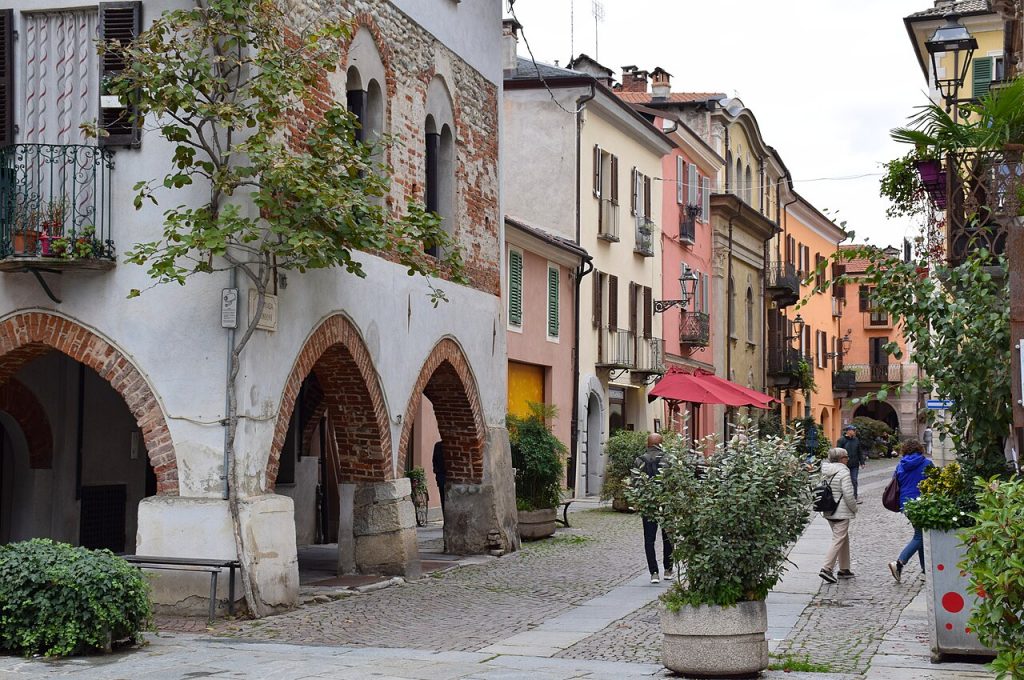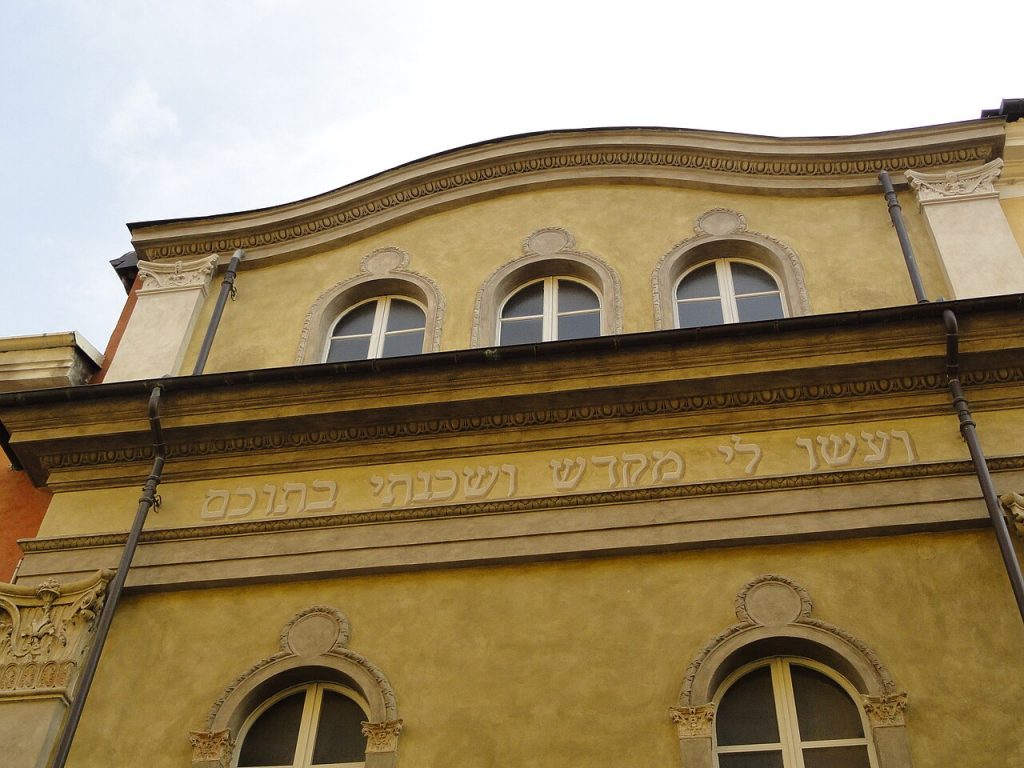
Located 90 km south of Turin and 45 km from the French border, the city of Cuneo was once home to one of the most important Jewish communities in Piedmont. Today, made up of about fifteen people, the community stands out for its attachment to its synagogue. Located in the heart of what was once the ghetto of the city, the synagogue was built in the seventeenth century and largely modified in the nineteenth century. It is currently only used for major holidays and certain family ceremonies.
The presence of the Jewish community is attested in Cuneo since 1406. Jews received a residence permit and the right to practice pawnshell. With the expulsion of the Jews from Avignon in 1570, Cuneo won a prosperous community from France. In the region from Cuneo to Montferrato, Jewish migrations from Provence lasted for decades. In 1630, the Jews of Cuneo were allowed to practice crafts and commerce without being subject to higher taxes than non-Jews. The Piazza Galimberti market, which was originally still on Saturday, is moved to Friday as a token of thanks for the help given by the city’s Jews during the siege of 1641.
In the eighteenth century, however, repressions, forced conversions, and ghetto settlements that began two centuries earlier in the rest of Italy reached Piedmont.
In Cuneo, restrictions, imprisonment, and various persecutions are attested by the writings of the famous Rabbi Lelio della Torre (born in Cuneo on January 11, 1805, and died in Padua on July 9, 1871) or by the historian of Jewish origin, Arnaldo Momigliano, (1908-1987), born in Caraglio (in French Carail) 10 km east of Cuneo.
When the ghetto was set up via Mondovi in September 1724, 134 Jews lived in Cuneo. The ghetto was limited to Via Mondovi and Chiusa Pesio. Every evening, as well as on Christian holidays, the ghetto was closed by four doors whose location is still visible. At the end of the 18th century, Jews were almost cut off from the rest of the population. The ghetto gates were removed during the Napoleonic period when the city was annexed to the French Empire and immediately restored at the Restoration in 1814, after the Congress of Vienna, with the return to the throne of Victor Emmanuel I. These bad conditions continued until 1848.
The census of Napoleon I of 1806, indicates that 215 Jews lived in Cuneo. This number will grow to 301 in 1835 and 320 in 1873. In the following decades, their number will reach 450, with the influx of families living in neighboring villages.

In 1848, the total civil and religious emancipation of the Jews was obtained by the status of Albertine, granted by King Charles Albert of Savoy. The community continues to expand, as evidenced by the work done to enlarge the synagogue.
But from the end of the nineteenth century, and even more in the early twentieth century, due to the industrialization of northern Italy, many Jews, especially young people, left the small towns of Piedmont to settle in the cities of Turin and Milan, where universities and industry are located. In 1936, there are only 46 Jews in Cuneo. The census of Mussolini, carried out in 1938, gives a number of 182 Jews for Cuneo, including those residing in Saluzzo, Mondovì, Fossano, Busca, Moretta and Cherasco.
Eight kilometers south of Cuneo, the Germans set up the Borgo San Dalmazzo concentration camp on the 12th of September 1943, just days after their entry into the region, where 349 foreign Jews, mainly from Central and Eastern Europe, were imprisoned and arrested by the Germans from 18 September. Some Italian Jews were also arrested in Cuneo on September 28, because of the lists provided by the Italian carabineers, but were released a few days before a circular from the Minister of the Interior, Guido Buffarini Guidi, ordered their arrest. On 21 November 1943, the majority of the prisoners were transferred to the Drancy camp near Paris before being sent to the Auschwitz extermination camp. Only 10 survived.
The camp closed temporarily after the departure of foreigners and was reopened from December 4, 1943 to February 15, 1944. This reopening was ordered by the police of Cuneo following a decree of December 2. All Jews, foreign or Italian, were hunted down. Most of the Jews in Cuneo, who had previously been arrested and later released, hid in the surrounding mountains, and the only ones arrested in Cuneo were the sick, the elderly, and some isolated people who had failed to hide. The Jews of Mondovi, warned in time, were able to hide. On the other hand, the Jews of Saluzzo will be arrested and deported to Auschwitz.
On April 25, 1945, the day of the liberation of Cuneo, the Germans, before leaving the city, snatched the six foreign Jews in the local prison and shot them under the arches of the bridge leading to the city. After the Second World War, in 1945, the Jewish community of Cuneo lost its legal autonomy and is nowadays integrated into the Jewish community of Turin.
The old Jewish cemetery located Calà degli Ebrei (currently Via della Pieve), was dismantled for the construction of a ramp, and the graves were transferred to a section of the communal cemetery via Bassa San Sebastiano.

Located in the heart of the ghetto, 18, Contrada Mondovì, the current synagogue, inaugurated in 1885, after the emancipation of the Jews, is the result of the many transformations of a pre-existing synagogue. The presence of a Dukan (pulpit) dating from 1611 suggests that the synagogue already existed at that time. It is the oldest of the sixteen synagogues still existing in Piedmont.
The facade of the building is framed by two pilasters, on which rests the entablature, which separates the first two levels of the third, slightly set back and surmounted by a curved cornice. On the frieze of the entablature is inscribed in Hebrew letter one of the verses of the book of Exodus: “They will make me a sanctuary, and I will live in the midst of them”. On the ground floor, two wooden doors with a semicircular arch and a doorpost surmounted by a circular cartouche provide access, one to the community office and the other to the synagogue. On the first floor, above the doors, two windows take the same decoration as the doors. On the second floor, above the entablature, are the three windows opening onto the women’s gallery.
Entering through the right door, you climb a staircase that leads first to the classroom level and then to the prayer room. We enter it by a small door at the back. The room is rectangular and has on each side wall two rectangular windows, providing natural lighting. The gray walls are enhanced by golden moldings. A cornice borders the slightly vaulted ceiling, decorated in trompe-l’oeil, representing a dome without a drum. Along the cornice, gilded cartouches contain Hebrew inscriptions.

The Teva, which is accessed by climbing two steps, is surrounded by a wooden balustrade. It is located just in front of the Venetian Baroque eighteenth-century Arche, whose finely carved, gold-painted wooden doors represent a large Menorah (seven-branched candelabrum) at the bottom of the instruments. sacrificial, Aaron’s rod, olive branch, and pot of manna.
On the same wall as the Holy Ark, on the upper left, was added to the post-emancipation period, a pulpit, imitating that of the Christian churches, and just below this pulpit is embedded a cannonball of Austrian origin, which passed through the synagogue without exploding on November 8, 1799, during the siege of the city, at the time of prayer, without causing any casualties among the faithful. This miracle was long celebrated year after year by the Jewish community of Cuneo under the name of Purim of Cuneo. Crystal chandeliers and gilded bronze complete the natural lighting.
The restoration work undertaken in recent years has focused on preserving existing structures and restoring original artifacts, so the prayer room has been fully restored to its original configuration. The restoration of the prayer hall and the facade was followed first by the architect Mariano Noggia, then by the architect Laura Menardi. The facade and prayer room are now completed and continue in adjacent rooms.
At the first level is a classroom, relatively narrow, equipped with benches, a blackboard, and an abacus to learn calculation. There is also a small library containing ancient texts in Hebrew.
(Source: Wikipedia)